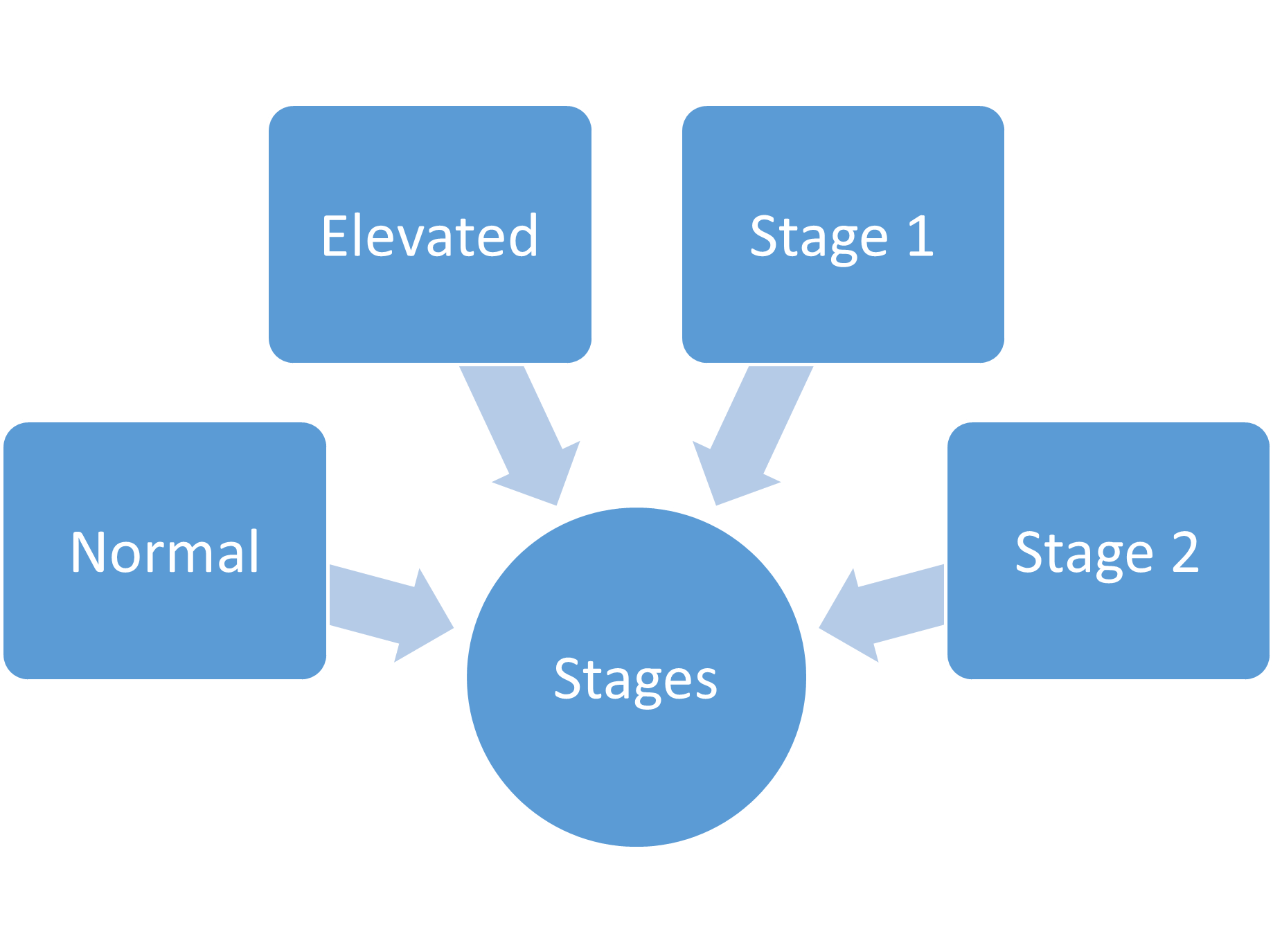What does hypertension/ high blood pressure mean?
Hypertension/high blood pressure is a medical term that consists of two words, “hyper” and “tension.” Hyper means more than usual quantity, and tension is a force. So hypertension implies a force that is more than is required.
The biological meaning of hypertension/ high blood pressure
In biology or medicine, “Hypertension” is related to high blood pressure, i.e., blood pressure is related to the rate at which the heart pumps blood. When the heart works faster or more than normal, that is required for a healthy body when the heart keeps pumping blood irregularly or at a faster speed. This, in turn, increases the pressure against the artery that it does not remain normal at all and lead to a certain disease, most commonly heart disease.
Systolic and diastolic blood pressure
Before understanding the stages of hypertension, one must know about the systolic and diastolic blood pressure. The pressure that blood exerts on the walls of arteries when heartbeats, i.e., oxygenated blood, is transported to the body is known as systolic pressure. In contrast, the pressure that blood exerts on the walls of arteries when the heart is resting between beats is known as diastolic pressure. Normal systolic pressure is less than 120 mmHg, while normal diastolic pressure is 80 mmHg. These two can also be termed upper and lower BP.
Difference between blood pressure and heart rate
The force that blood exerts on the walls of blood vessels on a unit area is termed blood pressure. While the number of times your heart beats within a minute is known as heart rate, heart rate is also known as pulse. The regular heart rate is 60 – 100bpm, while the regular blood pressure value is 120/80 mmHg.
Stages of hypertension/ high blood pressure
Following are the four stages of hypertension/ high blood pressure
- Normal.
- Elevated.
- Stage-1.
- Stage-2.

Normal stage
This is also known as stage-1 hypertension. The patient’s blood pressure is nearly normal, and the patient is not at risk. No treatment is necessary at this stage, but regular monitoring of blood pressure is required. It should be to make sure that blood pressure remains within the normal range. At the normal stage, systolic pressure is less than 120 mmHg, and diastolic pressure is less than 80 mmHg, remaining within this limit.
Elevated stage
This is also known as stage 2 hypertension. The BP of the patient is at risk of developing hypertension. There is no evidence of the patient using medicines to prevent this stage. The patient is at the level to cross the threshold to develop hypertension. The systolic pressure ranges from 120 mmHg to 139 mmHg, while the diastolic pressure ranges from 80 mmHg to 89mmHg, and this range is considered a safe range for anyone to develop heart diseases and stroke. People suffering from the elevated stage should make lifestyle changes to avoid the risk of hypertension that could lead to heart attack or stroke situation.
Stage 1 hypertension
A patient must consult the doctor at this stage as he is at a high risk of having a heart attack or other severe cardiovascular disorders. The BP of a patient suffering from stage one hypertension always has a systolic pressure ranging from 140 – 159 mmHg, while the diastolic pressure ranges from 90 – 99 mmHg. Doctors recommend you should have lifestyle and diet changes. Otherwise, the condition may become out of control. Particular types of drugs such as ACE inhibitors, angiotensin receptor blockers, calcium channel blockers, beta-blockers, and thiazide diuretics are prescribed by physicians.
Stage 2 hypertension
It is also known as fourth-stage hypertension. It is the most critical and alarming stage that causes a heart attack or stroke or leads to coronary disease. The patient is at high health risk. The doctor recommends combining medicine with a controlled diet and regular cardiac exercises. The patient’s blood pressure is as high that it ranges from160 mmHg or higher systolic pressure while 100mmHg or higher diastolic pressure. Regular measuring of BP is required at this stage.
Hypertensitive crises
This stage is when the patient’s BP is not under control anymore. It can damage any body organ and can lead to severe conditions. Blood pressure is 180mmHg or greater systolic and 120 mmHg or greater diastolic. It should be monitored many times within a day.
| Type | Systolic pressure | Diastolic pressure | Treatment |
| Type 1 | Less than 120 mmHg | Less than 80 mmHg | No treatment is required |
| Type 2 | 120 – 139 mmHg | 80 -89 mmHg | Lifestyle changes |
| Type 3 | 140 -159 mmHg | 90 – 99 mmHg | ACE inhibitors, angiotensin receptor blockers, calcium channel blockers, beta-blockers, and thiazide diuretics |
| Type 4 | 160 mmHg or higher | 100 mmHg or higher | Combination of medicines, strict diet, and exercise |
| Hypertensive crises | 180 mmHg or higher | 120 mmHg or higher | Proper medical treatment regular monitoring of BP. |
Types of hypertension/ high blood pressure
Following are the two main types of hypertension/ high blood pressure
- Primary hypertension
- Secondary hypertension
Some additional types of hypertension/ high blood pressure are following
- Isolated systolic hypertension
- Malignant hypertension
- Resistant hypertension
Primary hypertension
This type of hypertension is more common. Patients suffering from it have no apparent symptoms, but secondary symptoms include dizziness, headache, fatigue, etc. If the condition is not controlled or handled, it can persist and become severe with age.
Secondary hypertension
This type is the most common type of hypertension that is caused indirectly by some other medical condition or by the use of any other medicine, as it is related to some medical condition or medicine. So it usually gets normal when intake of medicine is stopped. Or another medical condition is normalized. An imbalanced diet such as a large number of salt intakes and alcohol drinking are also the causes of secondary hypertension.
Isolated systolic hypertension
A healthy vascular system is also essential to maintain healthy BP. Arteries are elastic to allow blood to pass through them easily. As a person gets older, arteries become less elastic, and blood finds it difficult to pass through them, which causes high blood pressure. Systolic BP is most important to maintain BP. In isolated systolic hypertension, the systolic pressure goes to 140 mmHg or above while the diastolic pressure remains normal or near to normal, like 90 mmHg. This type is common in people with having age greater than or equal to 65.
Malignant hypertension
If a person’s blood pressure rises extremely quickly, it leads to malignant hypertension. Only 1% of people suffering from hypertension suffer from this type of hypertension. The symptoms include numbness of hands, feet, blurred vision, chest pain, and confusion. And natives of Africa and America usually suffer from this type of hypertension. The diastolic pressure is greater than 130 mmHg, treatment in the hospital is necessary.
Resistant hypertension
If a person is suffering from hypertension and is taking medicines regularly, but BP is not in control and is resistant to any medicine, this type is known as resistant hypertension. This is maybe due to some genetic factors, lifestyle issues, or age factors.
You can consider treatment for your High blood pressure and hypertension, and more at Dr. Tetyana Metyk’s clinic. For additional information, please visit our Website. You can also Contact Us at any point for medical advice from a qualified physician.


This page really has all the information and facts I wanted about this subject and didn’t know who to ask.
Glucotrust: Medical science has witnessed sizeable progress prior to now
couple a long time. We have now recognized treatment plans
and vaccines for numerous large-danger illnesses and prevented them from resulting in long term
harm. Having said that, with time, our existence have worsened.
We’ve been a generation that thrives on junk food stuff, skips on physical exercises,
and Health and fitness! Our swiftly transforming life will be the persistent
reason for lifestyle ailments like diabetic issues, high cholesterol,
hypertension, coronary heart assaults, and so forth.
Hi! There are certainly a lot of details like that to take into consideration. That is a great point to bring up. I offer the thoughts above as general inspiration but clearly there are questions like the one you bring up where the most important thing will be working in honest good faith. I don?t know if best practices have emerged around things like that, but I am sure that your job is clearly identified as a fair game. Both boys and girls feel the impact of just a moment’s pleasure, for the rest of their lives.